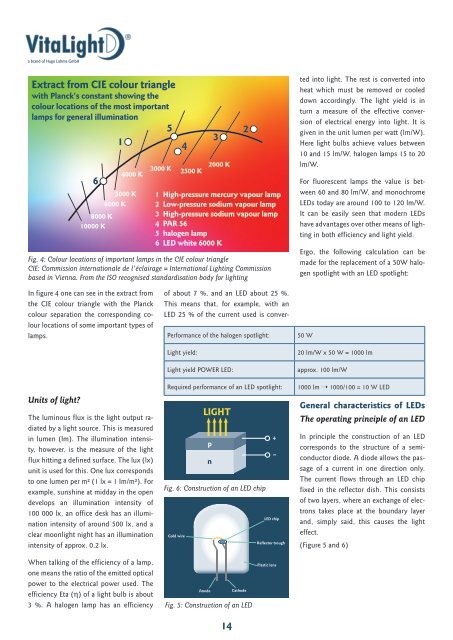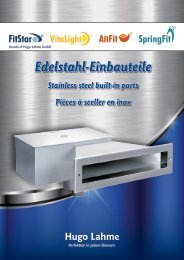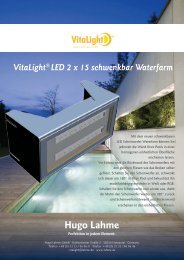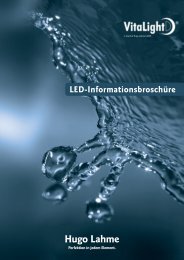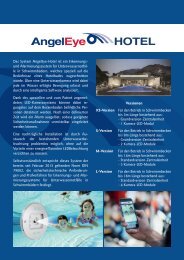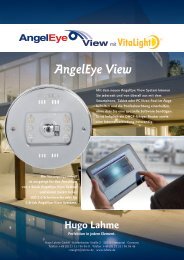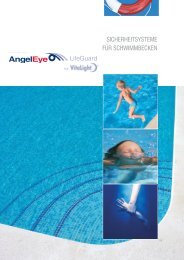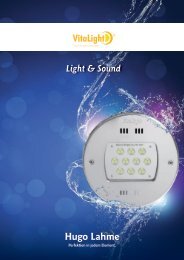VitaLight LED-Information englisch
You also want an ePaper? Increase the reach of your titles
YUMPU automatically turns print PDFs into web optimized ePapers that Google loves.
a brand of Hugo Lahme GmbH<br />
Extract from CIE colour triangle<br />
with Planck‘s constant showing the<br />
colour locations of the most important<br />
lamps for general illumination<br />
6<br />
8000 K<br />
10000 K<br />
1<br />
4000 K<br />
5000 K<br />
6000 K<br />
Fig. 4: Colour locations of important lamps in the CIE colour triangle<br />
CIE: Commission internationale de l'éclairage = International Lighting Commission<br />
based in Vienna. From the ISO recognised standardisation body for lighting<br />
5<br />
3000 K<br />
4<br />
3<br />
2500 K 2000 K<br />
1 High-pressure mercury vapour lamp<br />
2 Low-pressure sodium vapour lamp<br />
3 High-pressure sodium vapour lamp<br />
4 PAR 56<br />
5 halogen lamp<br />
6 <strong>LED</strong> white 6000 K<br />
2<br />
ted into light. The rest is converted into<br />
heat which must be removed or cooled<br />
down accordingly. The light yield is in<br />
turn a measure of the effective conversion<br />
of electrical energy into light. It is<br />
given in the unit lumen per watt (lm/W).<br />
Here light bulbs achieve values between<br />
10 and 15 lm/W, halogen lamps 15 to 20<br />
lm/W.<br />
For fluorescent lamps the value is between<br />
60 and 80 lm/W, and monochrome<br />
<strong>LED</strong>s today are around 100 to 120 lm/W.<br />
It can be easily seen that modern <strong>LED</strong>s<br />
have advantages over other means of lighting<br />
in both efficiency and light yield.<br />
Ergo, the following calculation can be<br />
made for the replacement of a 50W halogen<br />
spotlight with an <strong>LED</strong> spotlight:<br />
In figure 4 one can see in the extract from<br />
the CIE colour triangle with the Planck<br />
colour separation the corresponding colour<br />
locations of some important types of<br />
lamps.<br />
Units of light?<br />
The luminous flux is the light output radiated<br />
by a light source. This is measured<br />
in lumen (lm). The illumination intensity,<br />
however, is the measure of the light<br />
flux hitting a defined surface. The lux (lx)<br />
unit is used for this. One lux corresponds<br />
to one lumen per m² (1 lx = 1 lm/m²). For<br />
example, sunshine at midday in the open<br />
develops an illumination intensity of<br />
100 000 lx, an office desk has an illumination<br />
intensity of around 500 lx, and a<br />
clear moonlight night has an illumination<br />
intensity of approx. 0.2 lx.<br />
of about 7 %, and an <strong>LED</strong> about 25 %.<br />
This means that, for example, with an<br />
<strong>LED</strong> 25 % of the current used is conver-<br />
Performance of the halogen spotlight:<br />
Light yield:<br />
Light yield POWER <strong>LED</strong>:<br />
Required performance of an <strong>LED</strong> spotlight:<br />
Fig. 6: Construction of an <strong>LED</strong> chip<br />
Gold wire<br />
LIGHT<br />
p<br />
n<br />
+<br />
–<br />
<strong>LED</strong> chip<br />
Reflector trough<br />
50 W<br />
20 lm/W x 50 W = 1000 lm<br />
approx. 100 lm/W<br />
1000 lm ➝ 1000/100 = 10 W <strong>LED</strong><br />
General characteristics of <strong>LED</strong>s<br />
The operating principle of an <strong>LED</strong><br />
In principle the construction of an <strong>LED</strong><br />
corresponds to the structure of a semiconductor<br />
diode. A diode allows the passage<br />
of a current in one direction only.<br />
The current flows through an <strong>LED</strong> chip<br />
fixed in the reflector dish. This consists<br />
of two layers, where an exchange of electrons<br />
takes place at the boundary layer<br />
and, simply said, this causes the light<br />
effect.<br />
(Figure 5 and 6)<br />
When talking of the efficiency of a lamp,<br />
one means the ratio of the emitted optical<br />
power to the electrical power used. The<br />
efficiency Eta (η) of a light bulb is about<br />
3 %. A halogen lamp has an efficiency<br />
Anode<br />
Cathode<br />
Fig. 5: Construction of an <strong>LED</strong><br />
14<br />
Plastic lens


